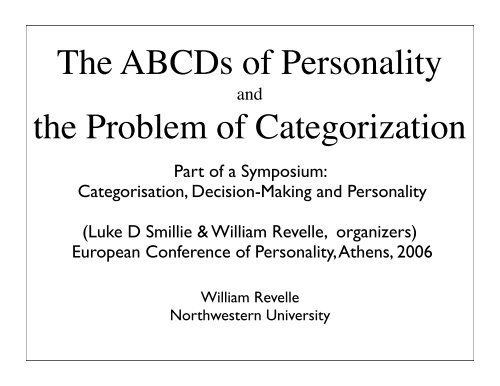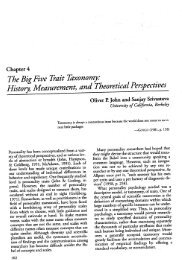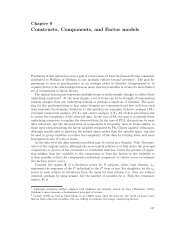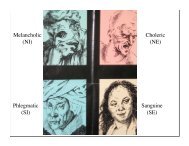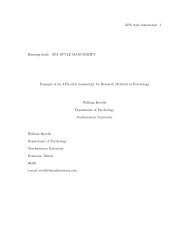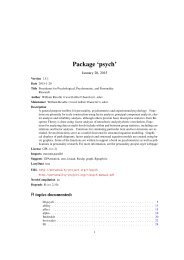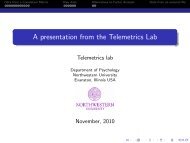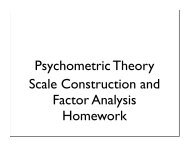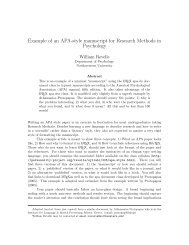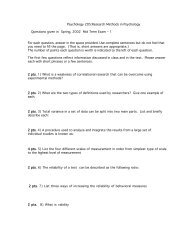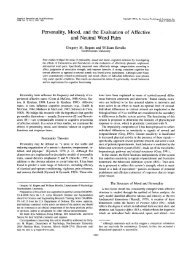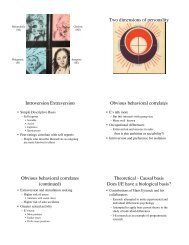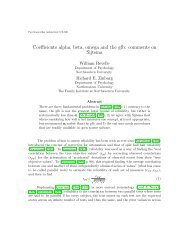The ABCDs of Personality - The Personality Project
The ABCDs of Personality - The Personality Project
The ABCDs of Personality - The Personality Project
You also want an ePaper? Increase the reach of your titles
YUMPU automatically turns print PDFs into web optimized ePapers that Google loves.
<strong>The</strong> <strong>ABCDs</strong> <strong>of</strong> <strong>Personality</strong>andthe Problem <strong>of</strong> CategorizationPart <strong>of</strong> a Symposium:Categorisation, Decision-Making and <strong>Personality</strong>(Luke D Smillie & William Revelle, organizers)European Conference <strong>of</strong> <strong>Personality</strong>, Athens, 2006William RevelleNorthwestern University
<strong>The</strong> <strong>ABCDs</strong> <strong>of</strong> <strong>Personality</strong>An important evolutionary challenge is to detect and attain food while avoidingbecoming food. More generally, this is the problem <strong>of</strong> approaching rewards andavoiding punishments. Structural models <strong>of</strong> affect distinguish between dimensions<strong>of</strong> positive and negative affect; contemporary personality theories organize traits interms <strong>of</strong> abilities to detect and achieve benefits or rewards while avoiding costs orpunishment. (E.g., Reinforcement Sensitivity <strong>The</strong>ory examines this challenge interms <strong>of</strong> a) individual differences in sensitivity to cues for reward and punishmentand b) in terms <strong>of</strong> behavioral activation (either approach or withdrawal) andbehavioral inhibition.)By examining the interrelationships <strong>of</strong> Affect, Behavior, Cognition, and Desires (the<strong>ABCDs</strong> <strong>of</strong> personality), we are able to tease apart the ways in which stablepersonality traits (e.g., E & N) reflect patterns in how current affective states andlong term desires combine to affect the cognitive representation <strong>of</strong> the environment.I will review prior work on personality and categorization and discuss how focusingon the cognitive and affective aspects <strong>of</strong> specific learning and judgment tasks allowsfor a richer understanding <strong>of</strong> the basis <strong>of</strong> personality traits.2
<strong>The</strong> Evolutionary Challenge inLewinian Space:Internal and External WorldsAn individual interacts with the worldPreyFoodMatesOffspringPredatorsE1Conspecifics
<strong>The</strong> Evolutionary challenge in LewinianSpace: Internal and External WorldsMultiple individuals interactingSelfMateOffspring
Focus on one individual’sinteractions with the worldExternal CuesOrganismic actionsInternal Affective States,Cognitive RepresentationsDesires and Goals
<strong>Personality</strong> and the <strong>ABCDs</strong><strong>Personality</strong> is an abstraction used to explain consistency andcoherency in an individual’s pattern <strong>of</strong> Affects, Cognitions,Desires and Behaviors. What one feels, thinks, wants and doeschanges from moment to moment and from situation to situationbut shows a patterning across situations and over time that maybe used to recognize, describe and even to understand a person.<strong>The</strong> task <strong>of</strong> the personality researcher is to identify theconsistencies and differences within and between individuals(what one feels, thinks, wants and does) and eventually to try toexplain them in terms <strong>of</strong> set <strong>of</strong> testable hypotheses (why onefeels, thinks, wants and does).Revelle, W. (in press) Experimental Approaches to the Study <strong>of</strong> <strong>Personality</strong>, in Robins, B., Fraley, C., and Krueger, R. <strong>Personality</strong> Research Methods6
<strong>The</strong> <strong>ABCDs</strong> <strong>of</strong> <strong>Personality</strong>• Affect (what we feel)• Behavior (what we do)• Cognition (what we think)• Desire (what we want)• Environment (where we are)•Ortony, A., Norman, D.A. & Revelle, W. (2005): Effective Functioning: A Three Level Model <strong>of</strong> Affect, Motivation,Cognition, and Behavior. in J. M. Fellous & M. A. Arbib (Eds.), Who Needs Emotions? <strong>The</strong> Brain Meets the Machine.New York: Oxford University Press. 7
<strong>The</strong> <strong>ABCDs</strong> <strong>of</strong> <strong>Personality</strong>BehaviorAffectDesiresCognition8
<strong>The</strong> <strong>ABCDs</strong> and thestudy <strong>of</strong> personality• Four fundamental components• Affect, Cognition, Desire, Behavior• Six pairwise “edges”• e.g., Affect x Cognition, Affect x Behavior,Cognition x Behavior, ...• Four facets (Affect x Cognition x Behavior, ...• Complete Integration requires ABCD 9
But, the <strong>ABCDs</strong> happen at threelevels <strong>of</strong> processing• Reflective– Control process monitors Reactive and Routine levels• Routine– External Cues evoke Action Tendencies– Action Tendencies elicit Actions– Actions reduce action tendencies• Reactive External Cues evoke fixed action patternsSee MacLean (1990), Ortony et al., (2005) Sloman &Logan(2005)
Information flow andinterruptsREFLECTIVEInhibition andactivationSensory inputs andmotor outputROUTINEREACTIVESOMATIC/MOTORTHE WORLDFigure 1. <strong>The</strong> three basic processing levels – Reactive, Routine, and Reflective, showing their interconnections and relationships both to one another, to somatic andmotor states, and to the state <strong>of</strong> the world. Small solid lines indicate both information content and interrupt signals that serve to initiate activity. Broken linesindicate excitatory and inhibitory influences from the reflective level to those below. Thick solid lines indicate response initiation (downward flowing arrows) andsensory signals (upward arrows) from both internal (the somatic/motor systems) and external sensors (sensing the environment).
Behavior at the Reactive LevelBehavior
Affect, Motivation and Behaviorat the Reactive LevelAffectMotivationBehavior
Affect, Motivation, Cognition andBehavior at the Routine LevelCognitionAffectBehaviorMotivation
Affect, Motivation, and Cognition atthe Reflective LevelCognitionAffectMotivation
Behavior across levels <strong>of</strong> processingImmediate Past Present Immediate future
Affect, Motivation, and Behavior interact across levels <strong>of</strong> processingAffectBehaviorMotivation
Affect, Motivation, Cognition and Behavior as interactingdomains across levels <strong>of</strong> processingAffectBehaviorMotivationCognition
Three levels <strong>of</strong> four modes• Reflective (controlled, conscious activity)• Routine (learned automatic procedures)• Reactive (fast pattern matching)Ortony, A., Norman, D.A. & Revelle, W. (2005): Effective Functioning: A Three Level Model <strong>of</strong> Affect, Motivation,Cognition, and Behavior. in J. M. Fellous & M. A. Arbib (Eds.), Who Needs Emotions? <strong>The</strong> Brain Meets the Machine.New York: Oxford University Press. 19
<strong>ABCDs</strong> applied to Affect• Differentiated vs. Undifferentiated Affect• Affect manifest at different levels• Reactive: proto-affect• Routine: primitive emotions• Reflective: full blown emotions•Progressively more differentiation from Reactivethrough to Reflective level• maximum undifferentiated = diffuse•maximum differentiated = “full blown” emotions(see Ortony, 2005, Affect and emotions in robots, Einstein Forum)20
Multiple formulations <strong>of</strong> themeasurement <strong>of</strong> affect• Categorical models <strong>of</strong> emotion (Eckman, Ortony)• Dimensional Models– Two dimensional models• Affective Valence and Arousal as “Core Affect” (Russell, Feldman-Barrett)• Positive and Negative Affect (Tellegen, Watson & Clark)• Energetic and Tense Arousal (Thayer)– Multidimensional models• Pleasantness-unpleasantness, rest-activation, relaxation-attention (Wundt)– (Reisenzein, Schimmack)• Energetic Arousal, Tense Arousal, and Hedonic Tone (Matthews)• Hierarchical models (Watson and Tellegen)
Structure <strong>of</strong> Affect and ArousalDepressedUnhappy.84.81Blue.84Sad.84NegativeAffect.55High TenseArousal.80Scared.61.70.78TenseAfraidNervous.07.29 .10-.24TiredDrowsySleepySluggish.88.90.92.75Low EnergeticArousal-.39-.09-.59-.38 -.36High EnergeticArousal.87.88.89.76EnergeticLivelyAlert-.17-.36.38.72PositiveAffect.77.73.70.82.86DelightedPleasedHappyFull <strong>of</strong> PepLow TenseArousalSatisfied.75Rafaeli and Revelle, 2006,.65.80.72ContentCalmAt EaseRelaxedMotivation and Emotion 22
<strong>Personality</strong>, Affect andCategorization: 5 examples• Trait and State Affect bias -> Cognitive Bias: Weiler, M. A (1992)Sensitivity to affectively valenced stimuli. Unpublished doctoraldissertation, Northwestern University, Evanston, IL.• Trait & State Affect -> Cognitive Bias: Rogers, G. and Revelle, W. (1998)<strong>Personality</strong>, mood, and the evaluation <strong>of</strong> affective and neutral word pairs.Journal <strong>of</strong> <strong>Personality</strong> and Social Psychology, 74, 1592-1605• Cognitive Representation -> Behavioral Variability Klirs, E. G. &Revelle, W. (1986) Predicting variability from perceived situationalsimilarity. Journal <strong>of</strong> Research in <strong>Personality</strong>, 20, 34-50.• Trait Cognitive -> Cognitive Bias: Yovel, I., Revelle, W., Mineka, S. (2005).Who Sees Trees before Forest? <strong>The</strong> Obsessive-Compulsive Style <strong>of</strong> VisualAttention Psychological Science 16, 123-129.• Affect -> Cognitive Bias: Gasper, K., & Clore, G. L. (2002). Attending tothe big picture: Mood and global versus local processing <strong>of</strong> visualinformation, Psychological Science, 13, 34-40. 23
<strong>Personality</strong>, Affect andCategorization: 5 examples1. Trait and State Affect bias -> Cognitive Bias2. Trait & State Affect -> Cognitive Bias3. Cognitive Representation -> BehavioralVariability4. Trait Cognitive -> Cognitive Bias:5. Affect -> Cognitive Bias24
Trait Affect versus Cognitive Semantics:Effects on Categorization(Weiler, 1992)• Analogy <strong>of</strong> color blind vs. shape blind individualdoing similarity judgement• Which <strong>of</strong> these belong together, which is not thesame? (<strong>The</strong> Sesame Street Game)Weiler, M. A (1992) Sensitivity to affectively valenced stimuli. Unpublished doctoral dissertation, Northwestern University, Evanston, IL.25
Weiler task: Categorization byAffect versus CognitiveAffect A Affect B Neutral BPositive A Positive B Neutral BNegative A Negative B Neutral B26
Weiler task: Categorization byAffect versus SemanticsAffect A Affect B Neutral BFall Down(- A)Hug(+ A)Drown(- B)Smile(+ B)Swim(B)Face(B)27
Sample TripletsBaseball Bullet KnifeBrutal Useless StrongCar wreck Final Exam Football gameComedy Failure TragedyBroiled Steak Chocolate cake Fried LiverCandy Acorn AppleCarnival Parade ProcessionCupcake Lifesaver RollAids28
Weiler model -- adaptedfrom J.A. Gray• <strong>Personality</strong> traits reflect differential sensitivities topositive and negative aspects <strong>of</strong> the environment• Sensitivity to positive cues independent <strong>of</strong> sensitivityto negative cues• Sensitivity to positive cues should increasecategorization based upon positive affect• Sensitivity to negative cues should increasecategorization based upon negative affect29
Sensitivity to PleasantSensitivity to Unpleasant-0.56 0.02 <strong>The</strong> beauty <strong>of</strong> sunsets is greatly over-rated.-0.55 -0.06 I prefer to take my bath or shower as quickly as possible just to get it over with.-0.51 0.09 <strong>The</strong> warmth <strong>of</strong> an open fireplace doesn't especially sooth or calm me.0.51 0.11 When I pass by a bakery, I just love the smell <strong>of</strong> fresh baking breads or pastries.0.5 -0.04 Beautiful scenery can touch something deep and strong inside me.0.47 -0.22 I have been fascinated with the dancing <strong>of</strong> flames in a fire place.-0.45 0.12 I don't find anything exhilarating about a thunderstorm.0.44 0.05 Having my back massaged feels wonderful to me.0.18 0.52 I am always adjusting the thermostat, or wishing I could.0.15 0.49 It is very annoying to me when a radio isn't tuned quite right.0.15 0.49 I find body odor extremely <strong>of</strong>fensive.0.15 0.48 I find it very disappointing when something doesn't taste as good as I thought it would.-0.05 -0.47 Bad odors have seldom bothered me.0.12 0.46 Even the smallest piece <strong>of</strong> gravel in my shoe just drives me crazy until I can get it out-0.09 0.44 I have terrible feelings when I am not sure I will succeed.0.31 0.42 It is important to me to get the water temperature just right when I take a bath or shower. 30
Sensitivities to pleasantness/unpleasantness and categorizationSense+ Sense- Pairs + Pairs - Val+ Val -S+ 0.85S- 0.03 0.78P+ 0.26 -0.15 --P- 0.13 0.24 -0.01 --V+ 0.53 -0.09 0.45 -0.04 0.90V- -0.01 -0.40 -0.08 -0.23 -0.24 0.89alpha reliabilities on diagonal 31
Effect <strong>of</strong> traits on classificationSens + Sens - Pairs + Pairs -Mood + 0.35 -0.13 0.19 0.20Mood - -0.30 0.13 -0.06 -0.20Ext 0.25 -0.06 0.29 -0.09Soc 0.31 -0.11 0.23 -0.10Imp 0.13 0.02 0.24 0.02Surg 0.43 0.02 0.17 -0.08Agree 0.29 -0.06 0.09 -0.20Intellect 0.35 0.07 -0.03 -0.01Neurot -0.17 0.35 -0.07 0.06Stability 0.18 -0.24 -0.09 -0.10Consc 0.15 0.23 -0.15 0.01Psychot -0.35 0.04 0.17 -0.0232
<strong>Personality</strong>, Affect andCategorization: 5 examples1. Trait and State Affect bias -> Cognitive Bias2. Trait & State Affect -> Cognitive Bias3. Cognitive Representation -> BehavioralVariability4. Trait Cognitive -> Cognitive Bias:5. Affect -> Cognitive Bias33
Trait and State Affect -> Categorization(Rogers & Revelle, 1998)•Differential susceptibilities to positive and negative affective states have beenproposed to underlie two major personality dimensions, Extraversion andNeuroticism, respectively. Concurrently, the influence <strong>of</strong> emotional states oncognitive processes has been heavily researched in clinical and socialpsychology. Four studies bridged these areas by investigating the relationsbetween Extraversion, Neuroticism, and the evaluation <strong>of</strong> affectivelypleasant, unpleasant, and neutral word pairs. Specifically measured wereaffectivity ratings, categorization according to affect, judgments <strong>of</strong>associative strength, and response latencies. A strong, consistent cognitivebias toward affective as opposed to neutral stimuli was found acrossparticipants. Although some biases were systematically related to personalityand mood, effects <strong>of</strong> individual differences were present only under specificconditions. <strong>The</strong> results are discussed in terms <strong>of</strong> a personality/moodframework and its implications for cognitive functioning.Rogers, G. and Revelle, W. (1998) <strong>Personality</strong>, mood, and the evaluation <strong>of</strong> affective and neutral word pairs. Journal <strong>of</strong><strong>Personality</strong> and Social Psychology, 74, 1592-160534
Trait and State Affect -> Categorization(Rogers & Revelle, 1998)• Trait: Extraversion, Neuroticism••• variation on the Weiler task•Positive and Negative Affect induction (Movies)Categorization and associative strengthRT and choice between two pairs <strong>of</strong> words• which pair is more “similar” 35
Which pair is more similar?art beauty knife killtruth honesty grief deathfamily friends devil satandream fantasy sin hellstars heaven hate despisebaby cute anger rageocean beach starving hungerwon victory larceny thiefrose smell criminal prisondancing fun war gun36
Pleasantness choice =f(E x N)37
Categorization <strong>of</strong> similarity:effect <strong>of</strong> valence on choiceand RTChoiceRT38
<strong>Personality</strong>, Affect andCategorization: 5 examples1. Trait and State Affect bias -> Cognitive Bias2. Trait & State Affect -> Cognitive Bias3. Cognitive Representation -> BehavioralVariability4. Trait Cognitive -> Cognitive Bias:5. Affect -> Cognitive Bias39
Cognitive representation <strong>of</strong>environment: effect on behavior• Individual differences in response to stressfulenvironments reflects cognitive representations <strong>of</strong>environment. (See Kelly, 1955)• Individual Differences in Multidimensional Scaling(INDSCAL) applied to commonly experiencedenvironments.• Examined how (reported) behavioral variability could bepredicted from individual perceptions and categorizations<strong>of</strong> stressful situationsKlirs, E. G. & Revelle, W. (1986) Predicting variability from perceived situational similarity. Journal <strong>of</strong> Research in<strong>Personality</strong>, 20, 34-50.40
Eight situations(chosen from 28 situations to reflect variability)• Giving a speech before a large group.• Talking to a best friend.• At a party with friends.• Paying a cashier.• Listening to a lecture.• Meeting a girl/boyfriend’s parents for the first time.• Advising a friend.• Meeting a distant relative for the first time.41
INDSCAL group spaceAnxietyInvolvementIntimacy42
Modeling cognitive representationspredicts cross situational variability• INDSCAL model allows for Nomothetic aswell as Idiographic fit for individuals.• Group space allows for nomothetic model•Individual weight space * Group space usesindividual categorization <strong>of</strong> environment topredict individual variability acrosssituations.43
<strong>Personality</strong>, Affect andCategorization: 5 examples1. Trait and State Affect bias -> Cognitive Bias2. Trait & State Affect -> Cognitive Bias3. Cognitive Representation -> BehavioralVariability4. Trait Cognitive -> Cognitive Bias:5. Affect -> Cognitive Bias44
<strong>Personality</strong> and Breadth <strong>of</strong> Attention(Yovel, Revelle & Mineka, 2005)• Shapiro’s hypothesis <strong>of</strong> Obsessive vs.Hysteric <strong>Personality</strong> Disorders• Global-Local task <strong>of</strong> Navon• Obsessive-Compulsive and related traits(using SNAP and IPIP items)• Examined Local Interference as a correlate<strong>of</strong> Obsessive-CompulsiveYovel, I., Revelle, W., Mineka, S. (2005). Who Sees Trees before Forest? <strong>The</strong> Obsessive-Compulsive Style <strong>of</strong> VisualAttention Psychological Science 123-129. 45
Navon: Forest - Trees taskConsistentGlobal and LocalTTTTTH H HHHHHHH H TInconsistentGlobal and LocalHHHHHT T TTTTTTT T HGlobal - NeutralOOOOOO O OOOOOOO O OLocal - NeutralHHHHHH TTTTTTH H T THHHHHH TTTTTT46
Reaction Time Measures <strong>of</strong> Local/Global InterferenceRT650600550500450400TTTTTH H HHHHHHH H TTTTTTH H HHHHHHH H TLocal LevelGlobal LevelHHHHHH TTTTTTH H T THHHHHH TTTTTTglobalprecedenceOOOOOO O OOOOOOO O OHHHHHT T HTTTTTTT T HConsistent Neutral InconsistentglobalinterferencelocalinterferenceHHHHHT T TTTTTTT T H47
<strong>Personality</strong> correlatesTraitwith RT measuresGlobalPrecedenceGlobalInterferenceLocalInterferenceHPD 0.06 0.04 0.19OCPD 0.16 0.11 0.33Entitlement 0.07 0.08 0.32Exhibitionism 0.02 0.08 0.21Impulsivity 0.00 0.06 0.13Propriety 0.12 0.11 0.16Workaholism 0.15 0.03 0.2748
<strong>Personality</strong>, Affect andCategorization: 5 examples1. Trait and State Affect bias -> Cognitive Bias2. Trait & State Affect -> Cognitive Bias3. Cognitive Representation -> BehavioralVariability4. Trait Cognitive -> Cognitive Bias:5. Affect -> Cognitive Bias49
Affect and breadth <strong>of</strong> processing:Categorization(Gaspar and Clore, 2002)• Positive Affect broadens, Negative Affectnarrows the focus <strong>of</strong> attention• Induction <strong>of</strong> Affect by AutobiographicalMemories• Categorization <strong>of</strong> objects by superordinate orsubordinate characteristicsGasper, K., & Clore, G. L. (2002). Attending to the big picture: Mood and global versus local processing <strong>of</strong> visualinformation, Psychological Science, 13, 34-40. 50
Affect and Attention (Reactive)• mood induction (autobiographical event)• which comparison figure is more similar to target ?Affect and Attention (Reactive)Affect and Attention (Reactive)Gasper, K., & Clore, G. L. (2002). Attending to the big picture: Mood and global versus local processing <strong>of</strong> visual information,Psychological Science, 13, 34-40.51
Affect and AttentionAffect and Attentionlocally similarglobally similar52
Affect and Attention (Reactive)Affect and Attention (Reactive)locally similarnegative mood ≈ 60%positive/neutral ≈ 30%globally similarpositive/neutral ≈ 70%negative mood ≈ 40%53
<strong>ABCDs</strong>, <strong>Personality</strong> andCategorization• Analysis <strong>of</strong> personality requires analysis in terms <strong>of</strong>fundamental components (<strong>ABCDs</strong>)• Individual components, pairs <strong>of</strong> components(edges), triples <strong>of</strong> components (facets) and acomplete integration helps us understandindividual differences in categorization <strong>of</strong>rewarding, neutral, and punishing environmentalcues.for further information: http://personality-project.org/revelle/publications/ecp.06.pdf54
ReferencesGasper, K., & Clore, G. L. (2002). Attending to the big picture: Mood and global versus localprocessing <strong>of</strong> visual information, Psychological Science, 13, 34-40.Klirs, E. G. & Revelle, W. (1986) Predicting variability from perceived situational similarity.Journal <strong>of</strong> Research in <strong>Personality</strong>, 20, 34-50.Ortony, A., Norman, D.A. & Revelle, W. (2005): Effective Functioning: A Three LevelModel <strong>of</strong> Affect, Motivation, Cognition, and Behavior. in J. M. Fellous & M. A. Arbib (Eds.),Who Needs Emotions? <strong>The</strong> Brain Meets the Machine. New York: Oxford University Press.Rafaeli, E. & Revelle, W. (2006). A premature consensus: Are happiness and sadness trulyopposite affects? Motivation and Emotion.Rogers, G. and Revelle, W. (1998) <strong>Personality</strong>, mood, and the evaluation <strong>of</strong> affective andneutral word pairs. Journal <strong>of</strong> <strong>Personality</strong> and Social Psychology, 74, 1592-1605Weiler, M. A (1992) Sensitivity to affectively valenced stimuli. Unpublished doctoraldissertation, Northwestern University, Evanston, IL.Yovel, I., Revelle, W., Mineka, S. (2005). Who Sees Trees before Forest? <strong>The</strong> Obsessive-Compulsive Style <strong>of</strong> Visual Attention. Psychological Science, 16, 123-129.for further information: http://personality-project.org/revelle/publications/ecp.06.pdf55


